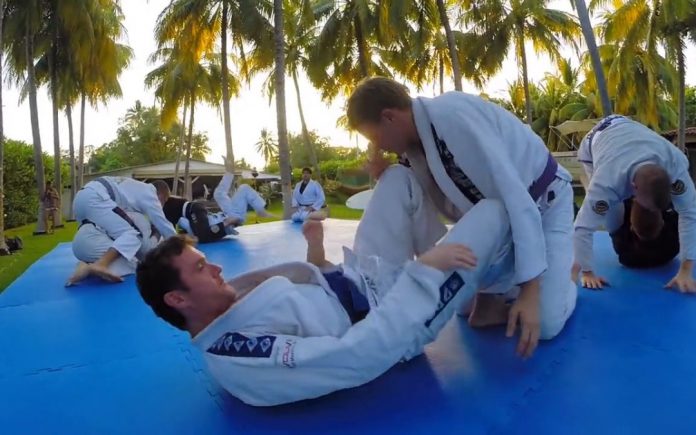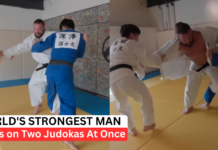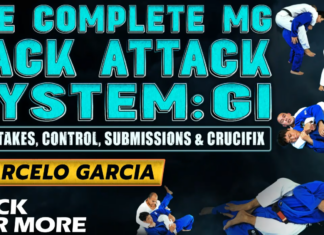
Rolling is by far the most interesting and fun aspect of training Brazilian Jiu-Jitsu. It is arguably the most anticipated part of the class where newly acquired knowledge gets “battle-tested”.
When you ask yourself what is rolling in BJJ, what is the first thing that comes to your mind? If it is fighting, you should reconsider your goals. A much more valuable intention of going for a roll in BJJ is learning how to do something against resistance. Jiu-Jitsu rolling is an invaluable tool for helping you make the distinction between what works for real and what looks good on YouTube.
Although it may seem like a chaotic scramble to the untrained eye, a BJJ roll is a highly technical affair. Contrary to the initial appearance, the goal is bringing order to chaos and exerting maximal control over an opponent. There’s a method behind all the apparent madness of a roll and it’s quite simple – to improve your Jiu-Jitsu.
BJJ Rolling Goals
A BJJ roll can be approached in a variety of ways, all stemming from the initial goal of the practitioner. Understanding the point of going for a roll in BJJ has a lot to do with the goals of your training that extend past the technical portions of classes:
- There’s the white belt’s style of going all out, berserker-style, and exhausting themselves after every roll.
- Then, there is the competitor approach, where the goal is to look for specialized moves that make up your competitive game plan.
- The older grappler would most likely employ a defensive-minded approach and focus on counterattacking strategies and technique over power.
- Last but not least, the brown/black belt who’s in an experimental phase would look for a partner willing to flow roll to polish out the finest details of specific parts of the art of BJJ.
No matter which approach you take, keep in mind that you’re in class to learn, not fight. Rolling is a teaching tool first and foremost, aiming to introduce a scenario that matches the reality of a live match.
During a roll, you get to experience all the different ways in which a technique or a move can fail. And, yes, it’s all about how a move can fail, before you can ever think about it succeeding with it against resistance.
Learning to Lose
If you’ve ever competed you’ve most likely lost, unless you’re the next big thing in Jiu+Jitsu. Joking aside, even if it’s the first tournament you’ve ever grappled in, the impressions you take away from the match(es) you’ve lost are always more lasting compared to the ones you’ve won.
That is exactly the point. Failure has more of an effect than success, which leads us to strive to avoid it at every cost, thus making failing a valuable learning experience. And there is no way to learn BJJ without constant failure. I never said it was easy to roll.
After the first time you get reversed when you had top side control, and end up losing the match as a result, you’ll never make the same mistake again. You might make another mistake with the same outcome, maybe, but that just adds to the lessons learned about pinning for side control.
Since we agreed that rolling is a great tool to simulate a match environment, the same idea of learning from failing applies. In fact, it is even more important to learn while you roll in BJJ class than to lose matches. Trying to figure out where your moves fail will teach you how to execute them correctly down to the smallest detail.
How to Roll in BJJ
One thing to keep in mind as you embark on exploring rolling in Brazilian Jiu-Jitsu is to consider the fact that you’ll rarely roll against someone matching you in weight, age belt level, and sex. That is one of the main draws of rolling – the option to explore BJJ with differently built and experienced training partners.
So how do you approach rolling with those higher in rank than you, as opposed to the ones with lower belts? How about your peers? Let’s answer all these questions:
1. Rolling With Lower Belts – Find What Works
Now that we’ve cleared up the purpose of rolling let’s focus on how to approach different training partners. In simple terms, adult BJJ belts range from white to black in a total of 5 colors.
So, let’s say that there are 5 levels of opponents available to roll with. Let our representative be an experienced purple belt with a couple of stripes. At purple belt, individuality comes to the surface defining the style of Jiu-Jitsu of the athlete.
So, how does our imaginary purple belt do in 3 rounds of rolling with lower belts? Let’s take a closer look:
- In a roll with a white belt that’s been around for 6 months, our purple belt is going to dominate. Easily, and in every area.
- In the second round of rolling, he/she goes for a fresh blue belt and brushes past them as well, although with a bit more effort.
- The next roll requires even more focus as this time the blue belt is one who’s a seasoned competitor and just a couple of classes away from receiving a purple belt.
It’s clear that even in the “lower tiers” of a class, there are levels that dictate how a roll should be approached. In this context, I completely agree with John Danaher that if you want to improve, you have to roll in BJJ mostly with lower belts.
When you roll with those below your rank, you can try new things out regularly and discover what works for you without having to defend things you don’t understand yourself.
For example, if you’re a purple belt learning a certain technique, a white belt would be the first partner to attempt it with. The fresher the white belt, the better.
Once you can successfully apply the move to all levels of white belts in the room, it’s time to move on to the blue belts when you roll in BJJ class. Again, as you move up through the Jiu-Jitsu ranks, the technique gets even further polished and can now be attempted at a higher level.
2. Rolling With Your Peers – Fine Tuning
Our imaginary purple belt has finally worked out the major kinks in their first+choice move (let’s say it’s a guillotine choke) and they’re ready to attempt it against other purple belts.
Already cleared up through rolling, the choke mechanics are now a lot more precise and to the point and only require minimal improvements to work. The first real test comes against your peers – they not only know what you’re doing by now but also know enough about guillotines to make it a challenge to get them.
You’ve learned most about the finishing mechanics from hitting the guillotine against the lower belts. When you roll in BJJ with people near or at your level, the hard part is getting to the finish you need, which means this is the time when your entries and setups shape up.
Once you manage to get into the guillotine more often than not, you are ready for the next step – testing against brown and black belts.
3. Rolling With Higher Belts – The Real Test
By the time our purple belt friend is ready to test their move against brown belts, they are already known in the gym for a specific move. Let’s stick to the guillotine choke as our specialty move.
Half the population of the academy is already complaining about that particular guillotine choke. But the sternest test still awaits. It’s going to take at least half the amount of time it already took to work out all the kinks and make the move work on higher-ranked training partners.
Once it works on brown belts with a reliable referee of success, you can add the move to your purple belt competition arsenal. Unless you achieve this milestone as your roll in BJJ, there is no point in trying out to catch people in a competition with it.
In the final attempt to become known as the next big guillotine master, our purple belt starts to look for the choke against black belts. In all honesty, this is the time of managing expectations and facing reality.
The biggest indicator of success here is recognizing failure. Our imaginary purple belt has their work cut out if they think they’re getting a black belt straight away. Failure, once again, becomes the teacher and the goal is to start decreasing it with every roll. However, with every 10 failures, or so, you’ll sneak in the occasional tap from a black belt. And it feels priceless!
Lesson(s) Learned?
When you roll in BJJ, make sure you are rolling with a purpose, not just thrashing around and grabbing what appears. Instead, try to improve your game, or better yet, specific aspects of it every time you roll.
In that quest, use your training partners optimally – lower-ranked ones to figure out the mechanics of the move and same-level partners to perfect the entries and transitions. Test out the effectiveness of what you’ve developed against higher belts to gauge if you’re on the right track. Anything less and you are wasting your time when you roll in BJJ classes.
25 Reasons Why You Don’t Progress in Jiu-Jitsu As Fast As You Can


![Darce Choke Encyclopedia – Origins, Mechanics and Variations [2025] BJJ, choke, Brabo, BJJ Darce Choke, D'arce Choke, Darce BJJ Choke](https://bjj-world.com/wp-content/uploads/2017/11/JungPoirierLeeYahoo-218x150.jpg)














![Slicin’ Calves Mikey Musumeci DVD Review [2025] Slicin' Calves Mikey Musumeci DVD Review](https://bjj-world.com/wp-content/uploads/2025/04/slicin-calves-mikey-musumeci-dvd-review-218x150.png)
![Jiu-Jitsu For Old Guys Guard Retention Bernardo Faria DVD Review [2025] Jiu-Jitsu For Old Guys Guard Retention Bernardo Faria DVD Review](https://bjj-world.com/wp-content/uploads/2025/03/old-guys-guard-retention-bernardo-faria-dvd-review-218x150.png)
![X-Guard Trickery Kyle Sleeman DVD Review [2025] X-Guard Trickery Kyle Sleeman DVD Review](https://bjj-world.com/wp-content/uploads/2025/03/x-guard-trickery-kyle-sleeman-dvd-review-218x150.png)
![Countering with Crab Ride Anthony Budion DVD Review [2025] Countering with Crab Ride Anthony Budion DVD Review](https://bjj-world.com/wp-content/uploads/2025/03/countering-with-crab-ride-anthony-budion-dvd-review-218x150.png)

![How To Knee Cut Junny Ocasio BJJ DVD Review [2025] How To Knee Cut Junny Ocasio BJJ DVD Review](https://bjj-world.com/wp-content/uploads/2025/02/how-to-knee-cut-junny-ocasio-bjj-dvd-review-100x70.png)
![Advantage Over Time Outside Passing Jozef Chen DVD Review [2025] Advantage Over Time Outside Passing Jozef Chen DVD Review](https://bjj-world.com/wp-content/uploads/2025/03/outside-passing-jozef-chen-dvd-review-100x70.png)
![Double Sleeve Guard Jon Thomas BJJ DVD Review [2024] Double Sleeve Guard Jon Thomas BJJ DVD Review](https://bjj-world.com/wp-content/uploads/2024/10/double-sleeve-guard-jon-thomas-bjj-dvd-review-100x70.png)
![Flow Pressure Kauan Barboza DVD Review [2025] Flow Pressure Kauan Barboza DVD Review](https://bjj-world.com/wp-content/uploads/2025/02/flow-pressure-kauan-barboza-dvd-review-100x70.png)

![Master The Move Anaconda Strangle John Danaher DVD Review [2025] Master The Move Anaconda Strangle John Danaher DVD Review](https://bjj-world.com/wp-content/uploads/2025/02/anaconda-strangle-john-danaher-dvd-review-100x70.png)
![Finish on the Back Ethan Crelinsten DVD Review [2024] Finish on the Back Ethan Crelinsten DVD Review](https://bjj-world.com/wp-content/uploads/2024/10/finish-on-the-back-ethan-crelinsten-dvd-review-100x70.png)
![Dubious De La Riva Dominique Bell DVD Review [2024] Dubious De La Riva Dominique Bell DVD Review](https://bjj-world.com/wp-content/uploads/2024/10/dubious-de-la-riva-dominique-bell-dvd-review-100x70.png)
![Darragh O’Conaill Crucifix Encyclopedia DVD Review [2024] Darragh O'Conaill Crucifix Encyclopedia DVD Review](https://bjj-world.com/wp-content/uploads/2024/10/darragh-oconaill-crucifix-encyclopedia-dvd-review-100x70.png)
![I Got Your Back Jake Straus DVD Review [2025] I Got Your Back Jake Straus DVD Review](https://bjj-world.com/wp-content/uploads/2025/03/i-got-your-back-jake-straus-dvd-review-100x70.png)
![Intro To Hip Mobility for Guard Players Joshua Presley DVD Review [2024] Intro To Hip Mobility for Guard Players Joshua Presley DVD Review](https://bjj-world.com/wp-content/uploads/2024/09/hip-mobility-for-guard-joshua-presley-dvd-review-100x70.png)

![How to Double Leg Anyone Kevin Lee DVD Review [2024] How to Double Leg Anyone Kevin Lee DVD Review](https://bjj-world.com/wp-content/uploads/2024/11/how-to-double-leg-anyone-kevin-lee-dvd-review-100x70.png)
![Higher Tripod Passing Craig Jones DVD Review [2025] Higher Tripod Passing Craig Jones DVD Review](https://bjj-world.com/wp-content/uploads/2025/02/higher-tripod-passing-craig-jones-dvd-review-100x70.png)
![Gracie Secrets Closed Guard Kyra Gracie DVD Review [2024] Gracie Secrets Closed Guard Kyra Gracie DVD Review](https://bjj-world.com/wp-content/uploads/2024/12/closed-guard-kyra-gracie-dvd-review-100x70.png)

![Reverse Armlock Magid Hage DVD Review [2024] Reverse Armlock Magid Hage DVD Review](https://bjj-world.com/wp-content/uploads/2024/12/reverse-armlock-magid-hage-dvd-review-100x70.png)

![Forging The De La Riva Guard Giancarlo Bodoni DVD Review [2025]](https://bjj-world.com/wp-content/uploads/2025/02/de-la-riva-guard-giancarlo-bodoni-dvd-review-100x70.png)

![Edging Yourself Out Of Danger Craig Jones DVD Review [2024] Edging Yourself Out Of Danger Craig Jones DVD Review](https://bjj-world.com/wp-content/uploads/2024/12/edging-yourself-out-of-danger-craig-jones-dvd-review-100x70.png)


![Complete Front Headlock System Michael Pixley DVD Review [2024] Complete Front Headlock System Michael Pixley DVD Review](https://bjj-world.com/wp-content/uploads/2024/10/front-headlock-system-michael-pixley-dvd-review-100x70.png)
![Crossing and Spinning Steps To Attack Israel Hernandez DVD Review [2024] Crossing and Spinning Steps To Attack Israel Hernandez DVD Review](https://bjj-world.com/wp-content/uploads/2024/09/spinning-steps-to-attack-israel-hernandez-dvd-review-100x70.png)

